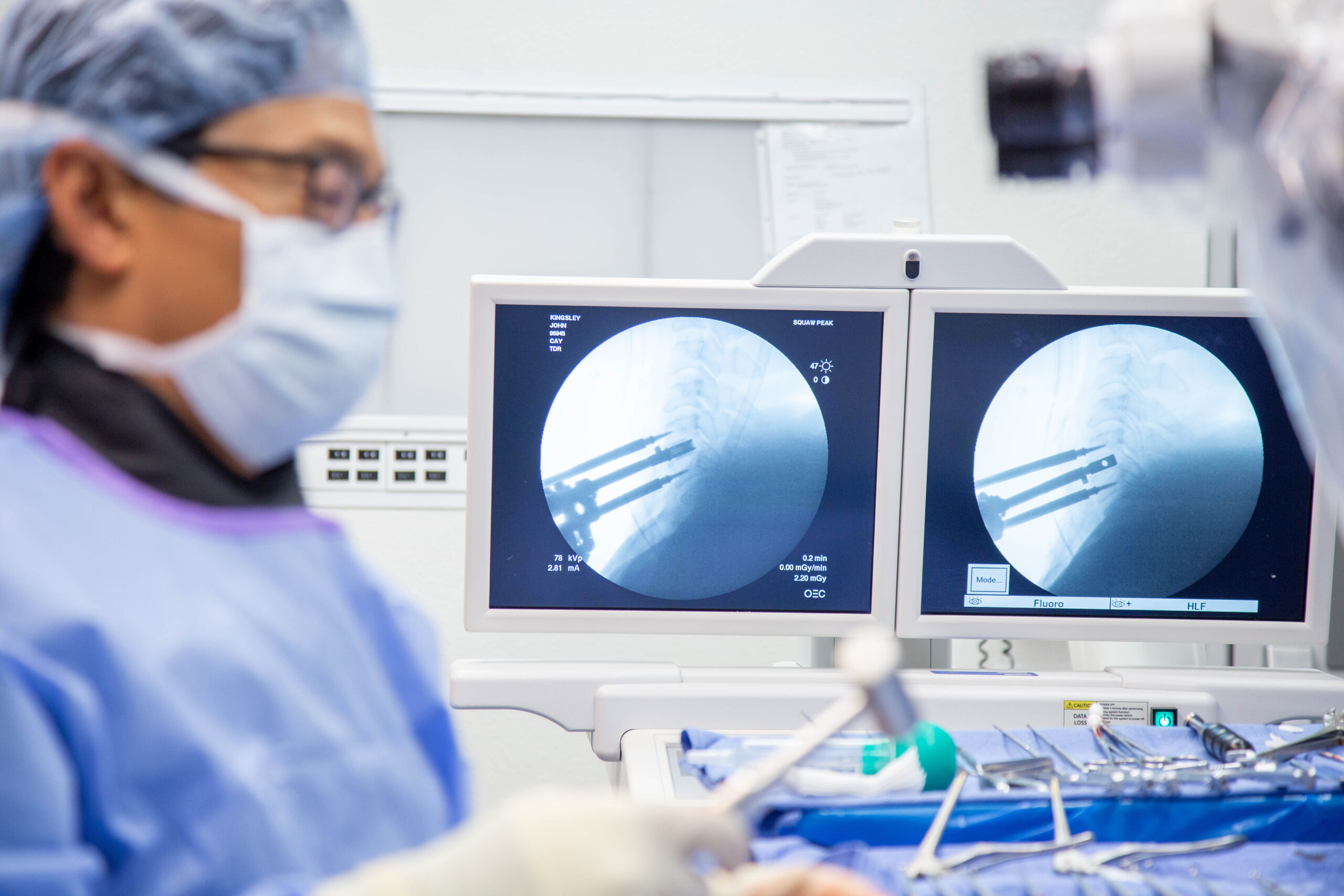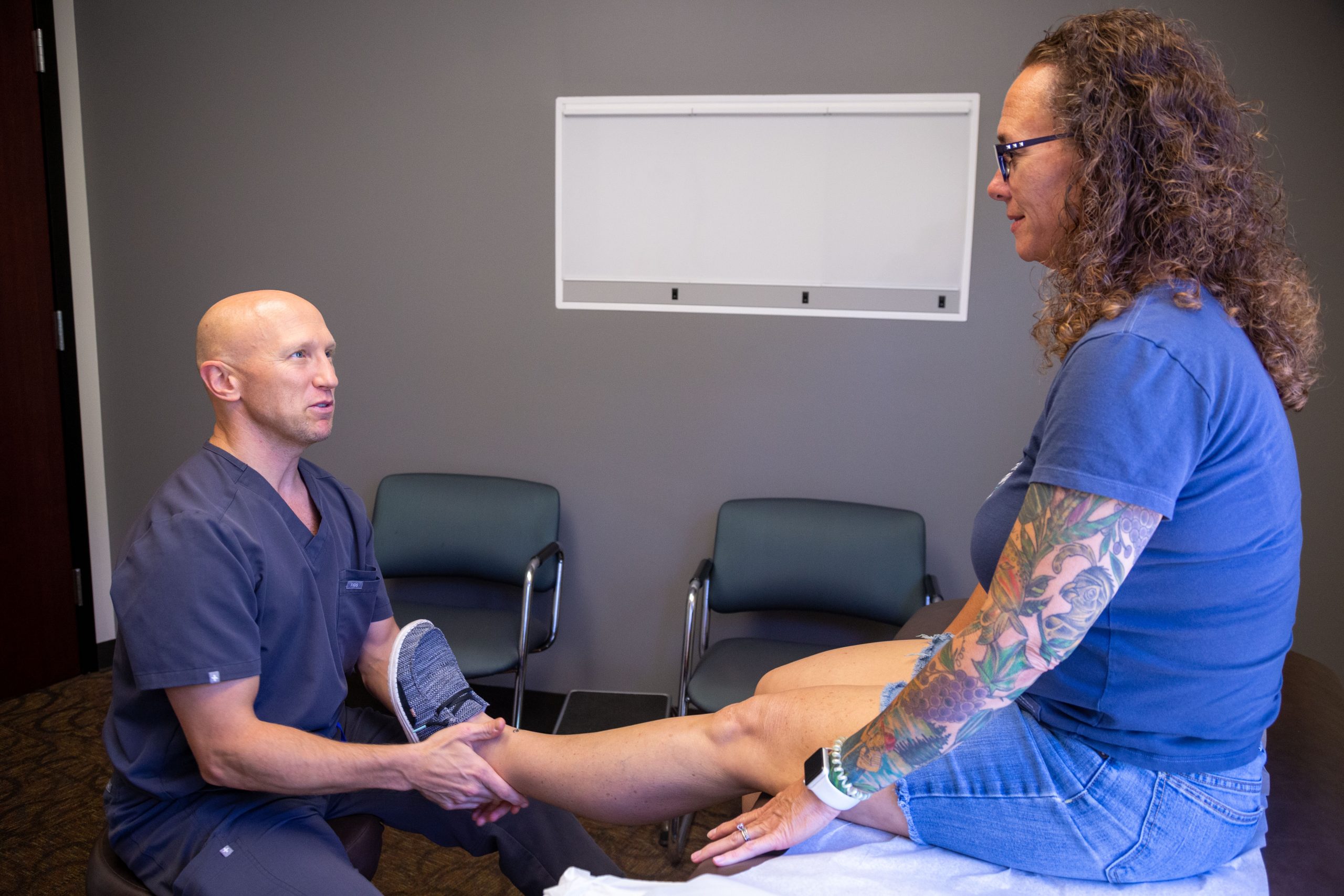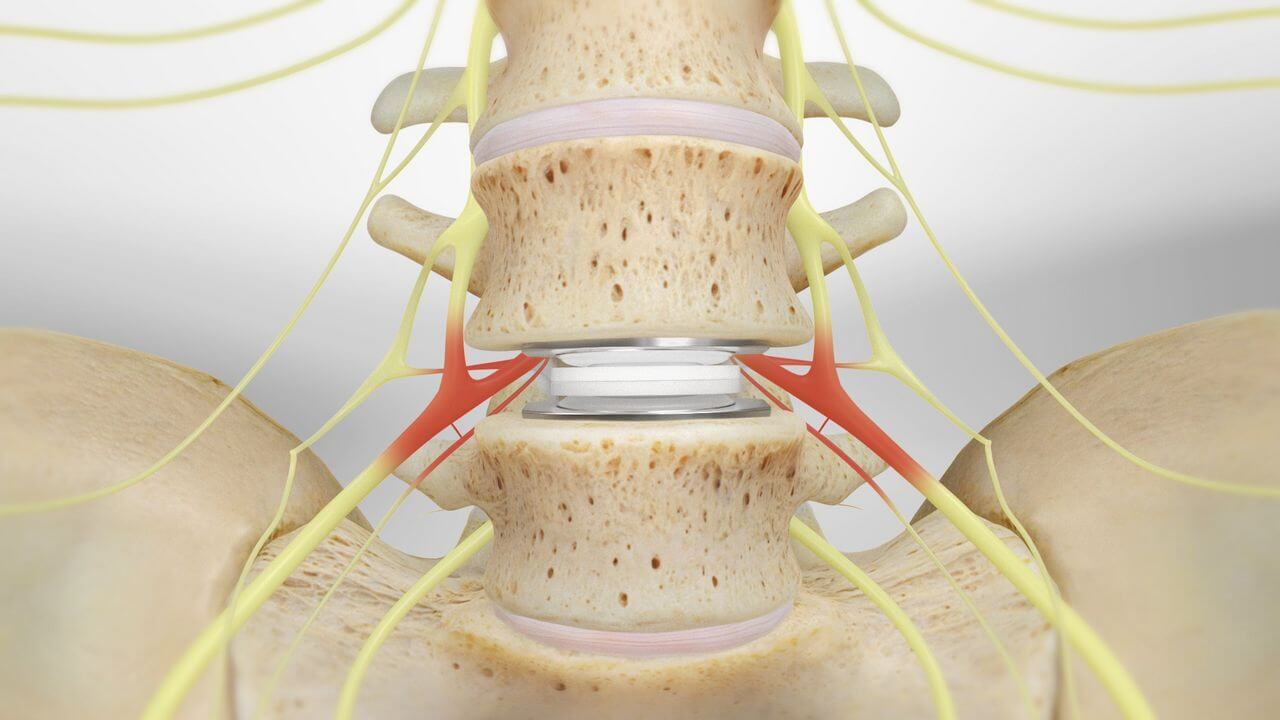If you have been experiencing chronic and severe lower back pain that has not responded to conservative treatments such as rest, physical therapy, medication, or injections, lumbar disc replacement might be considered as a treatment option.
A lumbar artificial disc replacement is a surgical procedure designed to treat certain types of lower back pain and degenerative disc diseases in the lumbar spine (lower back). The procedure involves removing a damaged or degenerated intervertebral disc in the lumbar region and replacing it with an artificial disc.
Intervertebral discs are soft, gel-like cushions located between each vertebra in the spine. They provide shock absorption and allow flexibility and movement in the spine. Over time, these discs can wear out, become damaged, or herniate, leading to pain and reduced mobility.
The goal of lumbar artificial disc replacement is to relieve pain, restore function, and maintain the natural movement of the spine. It is considered an alternative to traditional lumbar spinal fusion surgery, which permanently fuses two adjacent vertebrae together. Fusion restricts motion between the fused vertebrae but can lead to additional stress on the surrounding discs, potentially causing further problems in the long term.
In lumbar artificial disc replacement surgery, the surgeon makes an incision in the lower back and carefully removes the damaged disc while preserving as much healthy tissue as possible. Then, the artificial disc, made of metal or a combination of metal and plastic components, is inserted between the adjacent vertebrae. This device is designed to mimic the function of a natural disc, providing support and allowing controlled movement in the treated area.

In a recent systemic review of thirteen clinical studies found that the patient satisfaction rates for lumbar artificial disc replacement (LADR) were generally reported to be in the range of 75% to 93%. A total of 946 patients reported at least three years of follow-up results. This review shows that LADR effectively results in pain relief and an improvement in quality of life. The rates of complication and re-operation were acceptable.
The success of a lumbar artificial disc replacement depends on several factors, including the patient’s overall health, the surgeon’s experience, and adherence to post-operative care and rehabilitation. Also, it must be said that an accurate diagnosis of the pain generator within the lumbar spine is essential to a patient favorable outcome. The success rate may also change as technology and surgical techniques continue to advance.
Like any surgical procedure, lumbar artificial disc replacement carries some risks, such as infection, nerve damage, or device-related issues. Therefore, it’s essential to have a thorough evaluation and discussion with a qualified spine surgeon to determine if this procedure is the right option for a particular patient’s condition.
To determine if you are a suitable candidate for lumbar disc replacement, you will need to undergo a comprehensive evaluation, which may include:
It’s crucial to have a candid and open discussion with your healthcare provider about your symptoms, expectations, and any concerns you may have. They will be able to assess your individual case and advise you on the most suitable treatment options, including lumbar disc replacement if appropriate. Remember that surgery should always be considered as a last resort after exhausting conservative treatments, and the decision to undergo any surgical procedure should be made with careful consideration and expert guidance.

Lumbar artificial disc replacement (ADR) is a surgical procedure that comes with its own set of advantages and disadvantages. It is essential to thoroughly discuss these pros and cons with your healthcare provider to make an informed decision about whether this procedure is the right choice for your specific condition. Here are some of the pros and cons of lumbar artificial disc replacement:
Unlike traditional spinal fusion surgery, which restricts movement between the fused vertebrae, ADR aims to maintain the natural motion of the spine. This can potentially reduce stress on adjacent discs and joints, possibly leading to better long-term outcomes.
With ADR, there is a lower risk of developing adjacent segment disease compared to spinal fusion. Adjacent segment disease refers to the degeneration of discs and joints above and below the fused area due to increased stress on those segments.
ADR typically involves a shorter recovery period compared to spinal fusion surgery. Patients may experience quicker return to daily activities and work.
Some studies suggest that patients who undergo ADR may experience improved range of motion and functional outcomes compared to spinal fusion patients.
In spinal fusion, bone grafts are often used to promote fusion between the vertebrae. In ADR, bone grafts are not required, potentially reducing associated complications and pain at the donor site.
As with any surgical procedure, lumbar artificial disc replacement carries potential risks, and outcomes can vary depending on individual factors. It’s crucial to have a comprehensive evaluation and a thorough discussion with your healthcare provider to determine the best treatment approach for your specific condition and goals.
Not everyone is a candidate for lumbar artificial disc replacement. Patients with severe instability, multiple-level disc degeneration, spinal stenosis, or other spine-related issues may not be eligible for this procedure.
As with any implanted medical device, there is a risk of device-related complications, such as implant wear, dislocation, or failure. Additional surgery may be needed to address such issues.
Artificial disc replacement surgery can be more expensive than traditional spinal fusion, and it may not always be fully covered by insurance.
While short-term results are generally promising, there is still limited long-term data on the outcomes of lumbar artificial disc replacement compared to other treatment options.
In some cases, artificial discs may wear out over time, requiring revision surgery. The long-term durability of artificial discs is an ongoing area of research.
Any surgical procedure carries a risk of infection. Infections at the surgical site can range from mild to severe and may require additional treatment, such as antibiotics or, in rare cases, revision surgery.
During surgery, there is a possibility of unintentional injury to nearby nerves or blood vessels. This can lead to temporary or, in rare cases, permanent neurological deficits.
Artificial discs may have device-specific risks, such as wear and tear, dislocation, or mechanical failure. Although modern artificial disc designs aim to minimize these risks, complications can still occur, potentially requiring further surgery.
Some patients may experience an allergic reaction to the materials used in the artificial disc. It’s essential to inform your surgeon about any known allergies you have before the procedure.
While most patients experience improvements in pain and function after ADR, there is no guarantee of success. Some individuals may not achieve the desired pain relief or functional restoration they were hoping for.
Prolonged periods of inactivity during and after surgery can increase the risk of blood clots (deep vein thrombosis). Precautions, such as blood-thinning medications or early mobilization, are typically taken to reduce this risk.
General anesthesia carries its own set of risks, including reactions to anesthesia drugs and respiratory complications. Your anesthesia team will carefully monitor you throughout the procedure to minimize these risks.
Although ADR aims to reduce the risk of adjacent segment disease compared to spinal fusion, it is still possible for the adjacent discs to degenerate over time.
As with any surgical procedure, there is a risk of general complications, such as bleeding, scarring, and adverse reactions to medications.
Preparing for lumbar artificial disc surgery is crucial to ensure the best possible outcome and a smooth recovery. Schedule a comprehensive consultation with your spine surgeon to discuss your symptoms, medical history, and imaging results. Make sure to provide accurate information about any pre-existing medical conditions, medications you are taking, allergies, and previous surgeries.
By following the steps below and working closely with your healthcare team, you can prepare yourself physically and emotionally for lumbar artificial disc surgery and increase the likelihood of a successful outcome and a smoother recovery.

Ask your surgeon to explain the lumbar artificial disc surgery in detail, including the potential risks, benefits, and expected outcomes. Understanding the procedure will help you make an informed decision about undergoing surgery.
Your surgeon may order preoperative tests, such as blood work, electrocardiogram (ECG), and imaging studies (X-rays, MRI, or CT scans), to assess your overall health and the condition of your lumbar spine.
Review all medications you are currently taking with your surgeon. Some medications, such as blood thinners, may need to be adjusted or temporarily stopped before the surgery to reduce the risk of bleeding.
If you smoke, consider quitting or at least abstaining from smoking before and after surgery. Smoking can impair the healing process and increase the risk of complications.
Leading up to the surgery, focus on maintaining a healthy lifestyle by eating a balanced diet, getting regular exercise (as permitted by your surgeon), and managing any chronic health conditions.
Plan for someone to accompany you to the hospital on the day of surgery and to assist you during the initial recovery period. This support will be beneficial, especially during the first few days after the procedure.
Before the surgery, make necessary arrangements at home to ensure a comfortable recovery. Place essential items within easy reach, create a comfortable resting area, and consider aids like a walker or handrails if needed.
Your surgeon will provide specific instructions regarding fasting before the surgery. Typically, you will need to avoid eating or drinking anything for a certain period before the scheduled procedure time.
Make sure to inform your surgeon of any changes in your health leading up to the surgery, such as the development of a fever or signs of infection.
Preparing for surgery also involves mentally preparing yourself for the procedure and the recovery process. Stay positive and trust in your healthcare team’s expertise.
Don’t hesitate to ask any questions or express any concerns you may have about the surgery. Your surgeon and healthcare team are there to address your concerns and provide you with the information you need to feel confident about the procedure.
Lumbar artificial disc surgery, also known as lumbar disc replacement (ADR), is a specialized procedure performed by trained and experienced spine surgeons. The surgery involves removing a damaged or degenerated intervertebral disc in the lumbar spine (lower back) and replacing it with an artificial disc to restore motion and alleviate pain. Here is an overview of how the procedure is typically performed:
Before the surgery, you will be administered general anesthesia, which will put you into a deep sleep and ensure you feel no pain during the procedure. Then you will be positioning: You will be positioned on your back on the operating table to allow the surgeon access to your lumbar spine.
A vascular surgeon often assists the spine surgeon by making a small incision in your abdomen and safely retracting your stomach and intestines to access the lumbar spine with retractors. The size of the incision may vary depending on the specific artificial disc being used and the surgeon’s preference.
The spine surgeon will use specialized instruments to carefully remove the damaged or degenerated intervertebral disc from the space between the adjacent vertebrae. This process is called discectomy.
Once the damaged disc is removed, the surgeon will carefully prepare the space between the vertebrae to accommodate the artificial disc. The endplates of the adjacent vertebrae may be shaped and modified to ensure a secure fit. The appropriate-sized artificial disc is then selected based on your anatomy and the specific characteristics of the disc being used. The artificial disc is then inserted into the prepared disc space between the vertebrae. The design of the artificial disc allows it to mimic the function of a natural disc, providing support and allowing controlled motion.
The abdominal incision is carefully closed using stitches or surgical staples, and a sterile dressing is applied to the surgical site. After the surgery, you will be taken to the recovery room for monitoring as you wake up from anesthesia. You may need to stay in the hospital for a day or more for observation and pain management.
Physical therapy and rehabilitation may be recommended to help you regain strength, flexibility, and function in the lower back as you recover. It’s essential to follow your surgeon’s postoperative instructions carefully and attend all follow-up appointments to monitor your progress and ensure a smooth recovery. The recovery period can vary from patient to patient, but most individuals can gradually return to their daily activities and work within a few weeks to a few months after lumbar artificial disc surgery.

The recovery period following lumbar artificial disc surgery (lumbar disc replacement) is a crucial phase for allowing your body to heal and adapt to the new artificial disc.
Keep in mind that every patient’s recovery is unique, and individual factors can influence the timeline and outcome. Follow your surgeon’s instructions closely, attend all scheduled appointments, and communicate any concerns or unexpected symptoms with your healthcare team. With proper care and patience, many patients experience significant improvement in pain and function after lumbar artificial disc surgery.
The recovery timeline can vary from patient to patient, but here’s a general outline of what you can expect during the recovery process:
Most patients will stay in the hospital for a day or two after the surgery for observation and pain management. In some cases, patients may be discharged on the same day of surgery if they are recovering well, and your pain is managed and tolerated.
Early mobilization is essential to prevent complications and improve recovery. Your healthcare team will encourage you to get up and walk around with the help of physical therapists. However, you should avoid strenuous activities or heavy lifting during the initial recovery period.
Take care of the surgical incision as instructed by your surgeon. Keep the incision clean and dry and follow any dressing change instructions provided. Report any signs of infection, such as increased redness, swelling, or drainage, to your healthcare provider.
Physical therapy and rehabilitation play a vital role in the recovery process. Your physical therapist will guide you through exercises aimed at improving strength, flexibility, and mobility in your lower back.
Attend all scheduled follow-up appointments with your surgeon to monitor your progress and address any concerns or questions you may have.
Avoid driving until you are no longer taking pain medications that impair your ability to drive safely. The timeline for returning to work will depend on the nature of your job and how well you are recovering. Some people can return to desk jobs within a few weeks, while others with physically demanding jobs may need more time off.
Your surgeon may recommend wearing a back brace for a period after surgery to provide additional support during the early stages of healing. Follow your surgeon’s instructions regarding brace use.
As your recovery progresses, you can gradually resume normal daily activities and low-impact exercises. Always follow your surgeon’s guidance and avoid high-impact activities or sports that could put stress on the new artificial disc.
It may take several weeks to months to achieve a full recovery, depending on individual factors and the extent of the surgery. Be patient with the recovery process and avoid rushing back into strenuous activities too quickly.
If you are seeking a second opinion or looking to travel for a less invasive surgery, our orthopedic spine specialists in Phoenix are available to help you get an accurate spine diagnosis and customize an innovative treatment plan to get back to enjoying life. Schedule an appointment with one of our compassionate expert spine surgeons today.
Our spine health blog features up-to-date spine education and expert spine tips from our spine specialists here at DISC.
1635 East Myrtle Avenue Suite 100, Phoenix, AZ 85020, USA
18700 North 64th Drive Suite 105, Glendale, AZ 85308, USA
8630 East Vía de Ventura Suite 210, Scottsdale, AZ 85258, USA
3487 South Mercy Road, Gilbert, AZ 85297, USA
1635 East Myrtle Avenue Suite 400, Phoenix, AZ 85020, USA